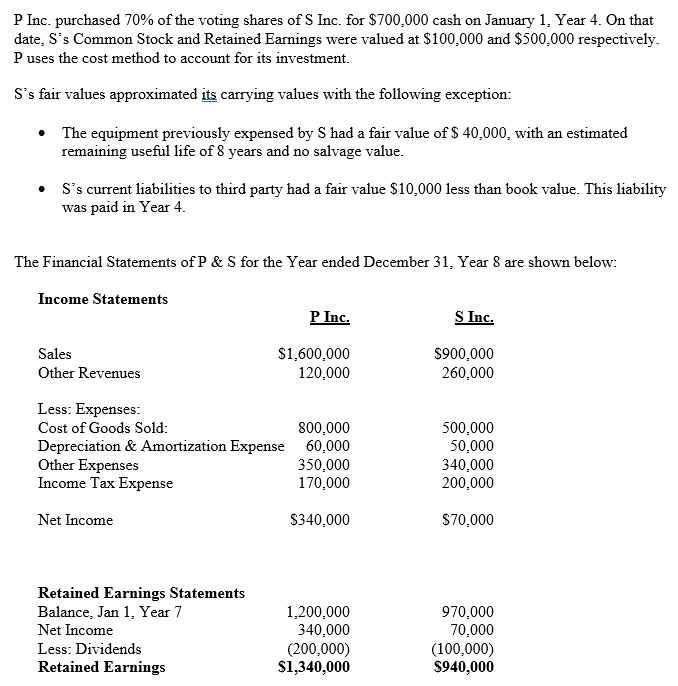Question
Questions 1. Calculate Goodwill, please show your work. 2. Prepare schedule calculating the consolidated Net Income. Shoe net income attributable to P and S. Do


Questions
1. Calculate Goodwill, please show your work.
2. Prepare schedule calculating the consolidated Net Income. Shoe net income attributable to P and S. Do NOT prepare a consolidated income statement.
3. On Consolidated Statement of Earnings for Year 8, what would be the balance for Sales?
4. On Consolidated Statement of Earnings for Year 8, what would be the balance for Other Revenue?
5. On Consolidated Statement of Earnings for Year 8, what would be the balance for the Depreciation Expense?
6. On Consolidated Statement of Financial Position as at Dec 31, Year 8, what would be the balance for Accounts Receivables?
7. On Consolidated Statement of Financial Position as at Dec 31, Year 8, what would be the balance for Investments ?
8. On Consolidated Statement of Financial Position as at Dec 31, Year 8, what would be the balance for Land?
9. On Consolidated Statement of Financial Position as at Dec 31, Year 8, what would be the balance for NCI?
10. On Consolidated Statement of Financial Position as at Dec 31, Year 8, what would be the balance for Common Shares?
11. On Consolidated Statement of Financial Position as at Dec 31, Year 8, what would be the balance for Inventory?
12. On Consolidated Statement of Financial Position as at Dec 31, Year 8, what would be the balance for equipment?
P Inc. purchased 70% of the voting shares of S Inc. for $700,000 cash on January 1, Year 4. On that date, S's Common Stock and Retained Earnings were valued at $100,000 and $500,000 respectively. P uses the cost method to account for its investment. S's fair values approximated its carrying values with the following exception: The equipment previously expensed by S had a fair value of $40,000, with an estimated remaining useful life of 8 years and no salvage value. S's current liabilities to third party had a fair value $10,000 less than book value. This liability was paid in Year 4. The Financial Statements of P & S for the Year ended December 31, Year 8 are shown below: Income Statements P Inc. S Inc. Sales $1,600,000 $900,000 Other Revenues 120,000 260,000 Less: Expenses: Cost of Goods Sold: 800,000 500,000 Depreciation & Amortization Expense 60,000 50,000 Other Expenses 350,000 340,000 Income Tax Expense 170,000 200,000 Net Income $340,000 $70,000 Retained Earnings Statements Balance, Jan 1, Year 7 1,200,000 970,000 Net Income 340,000 70,000 Less: Dividends (200,000) (100,000) Retained Earnings $1,340,000 $940,000 Balance Sheets P Inc. S Inc. $200,000 Cash 280,000 Accounts Receivable 300,000 290,000 Trademark 90,000 60,000 Inventory 280,000 200,000 Investments 700,000 30,000 Land 180,000 290,000 270,000 170,000 Equipment (net) Total Assets $2,100,000 $1,240,000 Current Liabilities 160,000 200,000 Common Shares 600,000 100,000 Retained Earnings 1,340,000 940,000 Total Liabilities and Equity $2,100,000 $1,240,000 Other Information: 1. During Year 5, S sold a parcel of land to P for $200,000 cash. S had purchased this land in 2013 for $180,000. P sold the land to third party in Year 8. 2. During December Year 7, P sold inventory to S for $100,000 cash, the cost of the inventory to P was $70,000. 20% of these goods remained in S's inventory at the end of Year 7. The inventory was sold to a third party during Year 8. 3. On December 30th, Year 8, P sold inventory to S for $100,000, the cost of the inventory to was $75,000. All the inventory remained in S's inventory at the end of Year 8. S paid $60,000 cash on delivery and the remaining $40,000 on March 2nd Year 9. 4. The Common Shares of P & S did not change since the date of acquisition. 5. Both companies use straight line amortization exclusively for all assets and liabilities. 6. The effective tax rate for both companies is 40%. 7. P has recorded the investment in S at Cost. 8. For Consolidation P uses the FVE methodStep by Step Solution
There are 3 Steps involved in it
Step: 1

Get Instant Access to Expert-Tailored Solutions
See step-by-step solutions with expert insights and AI powered tools for academic success
Step: 2

Step: 3

Ace Your Homework with AI
Get the answers you need in no time with our AI-driven, step-by-step assistance
Get Started


